MIT的物流与供应链管理(英文版)
- 格式:ppt
- 大小:3.67 MB
- 文档页数:7
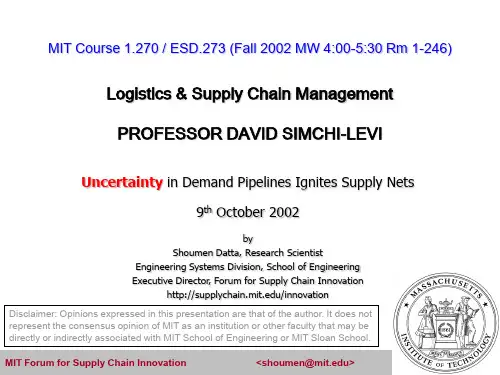

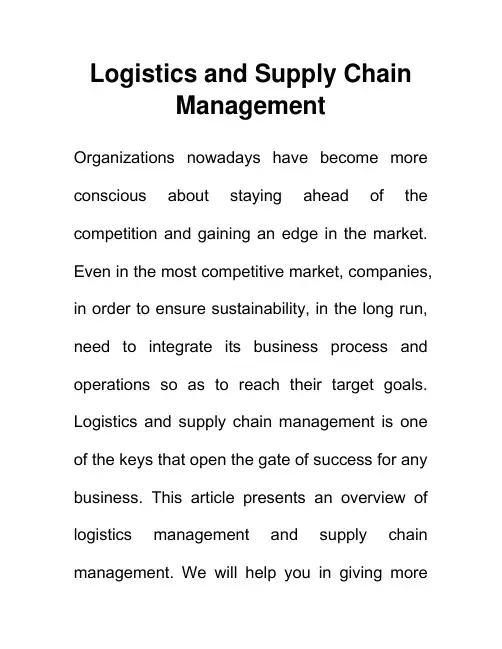
Logistics and Supply ChainManagement Organizations nowadays have become more conscious about staying ahead of the competition and gaining an edge in the market. Even in the most competitive market, companies, in order to ensure sustainability, in the long run, need to integrate its business process and operations so as to reach their target goals. Logistics and supply chain management is one of the keys that open the gate of success for any business. This article presents an overview of logistics management and supply chain management. We will help you in giving moredetails on Logistics and Supply Chain Management.Logistics and supply change management is used by the organizations to plan and control the activities and operations as well as coordinate amid the companies either in the same or adjacent industries. Though both these terms at times are used interchangeably, however, the supply chain management is an overall concept that connects the numerous processes of an organization to attain competitive advantages in the industry.On the other hand, logistic is the movement as well as the flow of products, services together with information within the supply chain. The logistics focus on the activities of the same company whereas the supply chain has widened focus due to the involvement of multiple enterprises such as manufacturers, suppliers as well as retailers.Logistics ManagementThe logistics work primarily for the requirement of the customers while supply chain management aims towards attaining competitive advantage for an organization. Therefore, it canbe said that logistic management is a crucial element of supply chain management. It enhances the aspects of the strategy, planning as well as implementation, thereby reducing the cost to provide maximum satisfaction to the customers.The role of logistics and supply chain management is to ensure that the product is delivered to the right customer at the right price as well as at the right time without any discrepancy or delay. Besides this, it involves activities such as transportation, warehousing,controlling stock and monitoring the inflow and outflow of goods from the organization.Supply Chain ManagementSupply chain engages activities such as operations and procurements which are necessary for efficient and effective running of business. It plays a vital role in the success of the company as it aims to accomplish the needs and demands, driving outstanding values from customers, enhancing the responsiveness of organization, building network resiliency and facilitating financial success.Thus, logistic management is an important part of the supply chain management as it involves carrying out of management in addition to information from the point of origin to the consumption-point.Planning and Controlling ActivitiesPlanning and controlling activities are among the most important functions of logistics and supply chain management.Activities and objectives are created under planning and implementing the same effectively under control. These two paradigms works forreconciliations between what is needed by the market and what can actually be delivered by the operation resources.Supply chain management involves the process that helps in the movement of the raw material from the beginning of the production till the deliverance of the goods to the end users. It has been found that in various companies, operational supply chain decisions are made more than a number of times affecting how products could be manufactured or developed, moved as well as sold.In an attempt to meet the challenges in delivering the goods to customers, companies have adopted automated logistics and supply chain management processes for efficient and significant impact on bottom lines.In order to attain a better profit margin, there are a few other important benefits of adopting an appropriate logistics and supply chain management technique or strategy, both into the factory, the warehouse and distribution channels. The intricacies of the supply chain vary with the business along with the obscurity and the quality of items being produced.Functioning of the Logistics and Supply ChainIt is the customers who start the chain of events while they make purchase decisions that have been offered by any company for sale. Logistics and supply chain management system not only enhances the service quality but also amplify productivity through the extraction of wastes.One of the most important things in the logistics and supply chain management process is to ensure that each activity adds value for the end users. If the product needs to be produced, the sales orders must include a prerequisite that is required to be fulfilled with the use of productionfunction. We will provide you proper guidance on Logistics and Supply Chain Management.PlanningThe planning department makes a production plan that includes the manufacturing details of the product in accordance with the demand of the customer and their orders. To manufacture the products the company then purchases the raw material.The planning department works at the administrative level of the organization. This department refers the project team who createthe master plan as well as sector plan along with many other planning efforts that works as the guiding information for the organization to help regulate those plans.PurchasingThe purchasing department receives a list of raw materials and services required by the production department to complete the customer’s orders. The purchasing process is considered crucial as it works as a tool to identify the requirements of the customers, evaluate the needs efficiently, identify thesuppliers, make sure payment occurs effectively and drive improvement continuously.The raw material is received from the suppliers; it is then checked for quality and accuracy and later moved into the warehouse.Inventory ManagementThe inventory management is important because it resists stock-outs, handle multiple locations and ensure appropriate accounting. Inventory is a term related to the stocking of the materials and represents those various levels from raw material to finished products. Based onthe production plan, the raw materials are moved to the production area.These raw materials are used to manufacture the finished product and then sent to the warehouse and stocked for shipping. Implementing a lean logistics and supply chain management in the production process is a key element that helps in developing long-term value and relationship with customers as well as increasing the overall organizational performance.ProductionThe production department in a company is responsible to handle a group of activities that involves the manufacturing process of the goods. This department is the largest group within the organization. It is responsible for transforming input into the final output using a set of the process needed for production.The production manager is responsible for ensuring that the raw material is obtained and transformed into finished good in an efficient way. From there the finished good is sent to the warehouse. The warehouse is considered as the key function as well as a destination in theoverall planning and implementation of supply chain management. It aims to receive and distribute the goods or materials. For many companies, it is concerned as a strategic function.PackagingOn the other hand, the packaging is also a key function in logistics and supply chain management. It is used for protecting finished good from damaging and allows for effective distribution of the products to the appropriate customers. It plays the role of product prompteras it communicates to the customers the information with regard to the goods.For a successful logistics and supply chain management, the packaging system is required to be connected with the activities of marketing, production as well as logistics. As soon as the finished products arrive in the warehouse, then the shipping department settles on the most competent methods to deliver the products to the right customers before or on the date as specified.This is the overall functioning of the logistics and supply chain management. It requires a lot ofefforts from the organization’s end to maintain a balance between the supply and demand of any product or service.A number of companies have segmented their logistics management streamlined it with the supply chain so as to enhance customer relationship together with lowering down their huge operational costs which might otherwise create a burden on the management. Both logistics and supply chain management are interlinked and so, it will not be wrong saying that one process cannot exist devoid of the other.We will now explain you about Inbound and Outbound Logistics.Inbound and Outbound LogisticsLogistics and Supply Chain Management enhances various activities such as inventory handling, as well as the packaging process of the products, transportation, and warehousing, delivery to the customers.There is no doubt that the smooth functioning of the organizations depends on the efficient management of supply and demand which in turn have a significant impact the overall imageand reputation of the organization in the eyes of the customers. In this era of globalization, the Logistics and Supply Change Management has become the most important tool to gain the competitive advantage of global market opportunities.Inbound operationsThe managers of inbound logistics as well as of outbound logistics play a vital role in the Logistics and Supply Chain Management. The inflow of the resources that a company needs to produce its products or render services is managed by the inbound logistics managers.They are responsible for building a relationship among the suppliers as well as retailers.Besides this they manage activities that are necessary for the manufacturing of products such as accessing raw materials, negotiating the price of materials and arranging fast delivery of the products that customers have ordered whereas the manager of outbound logistics deals with two issues including transportation and storage of the goods. They are responsible to implement the cost-saving strategies for the company along with maintaining the orders of the customers.Outbound operationsTo ensure that the good that is produced remains impeccable and safe to use, these managers use warehousing technique. The products may need to be transported as per the imminent demand of the customers and this makes the transportation a critical point which is affected by a number of factors such as a change in the price of fuel or delay delivery. So the outbound logistics manager needs to deal with factors that lead to proper transportation of the ordered products.The traditional organization used to treat them separately but at present, there is a certain value added functionalities associated with them due to their interdependency. In simple words, it is said that the Logistics and Supply Change Management helps in facilitating the manufacturing and marketing operations in an organization.Challenges in the Logistics and Supply Change ManagementAt present, in all the organization Logistics and Supply Change Management plays a vital role in the smooth working and success of a company.It represents various management functions in the organization. Either big companies or small firms all have somehow ort the other adopted effective Supply Chain Management techniques so as to meet their target objectives. However, in the era of globalization, almost all companies all around the world face some challenges in their management system.Though appropriate Logistics and Supply Chain Management provides the companies, especially manufacturing units’ competitive advantage as well as a business advantage;however, there are challenges too in the way of implementation of the system.Due to the increase in the market competition, the Logistics and Supply Chain Management System is facing an increasing number of challenges in the way of creating and running the management system efficiently and effectively. Globalization, consumers changing preferences, market growth, extreme work stress, growing demand of customers are among the major challenges the organizations face in the smooth running of the logistics management.Processing Enormous Amount of Data and InformationProduction of goods goes in a long process and managers are required to maintain a large amount of the details on daily basis. Due to globalization, the information about the suppliers as well as customers from the different location needs to be recorded appropriately and accurately.The managers’ needs to ensure the details about raw materials provided; security of the good, packaging, warehousing, shipment, labor agreement, taxes and pricing of the materialsand many others work’s details. These involve process that are not only complex but also time consuming which as a result leads to the distractions and stress.The long process sometimes also becomes tedious that diverts the mind of the managers from ensuring accuracy of the details.Details with regard to raw materials that need to be obtained from the retailers, suppliers as well as partners even including the customers are in both structures as well as in unstructured format which makes it difficult for the managers to identify, evaluate and produce information fromsuch disorganized pieces of detail. This makes Logistics and Supply Chain Management more complex.Manpower ManagementManpower management is one of the main hidden responsibilities of the managers in the organizations. It is one of the toughest tasks for the inbound logistic managers. They are responsible to maintain human approach and relationship among the workforce and simultaneously with aim to attain more success.Well! it is not as simple as it sounds, rather it worsens the work environment when the employees or staffs at remote locations are not managed appropriately.Offering Segmented,Customized ServicesThe logistics management involves the activities such as packaging of goods in a proper and attractive way and transportation of good to the right customer as per their demand.The organization needs to ensure that it must meet the demand of the local as well international standard of manufacturing,handling, and packaging as well as shipping of the products. Besides this, we have also heard about the changing trends in customers taste and preference. That too creates a burden on the big organization to deal with these demands.The organizations are continuously trying their best to fulfill the necessity of the customer and providing them maximum satisfaction but this is not as easy to do as to hear. Company has to keep enhancing the features and update itself with the new technologies for manufacturing and delivering the goods and render services associated with it according to the preferencesof the customers. Again a complex situation arises for the managers while ensuring appropriate implementation of logistics and supply chain management.Cutting Transportation CostIt is for sure that companies try to deliver the orders placed by the customers on time or before the expected time. Nevertheless transporting the goods to the customers living in the different geographical location is not easy for the company as it involves the various factors, particularly the escalation in freight charges or even a minor increase in the price of fuel. This isanother challenge for companies in the adoption of cost effective logistics and supply chain management.Besides this, companies also face major threat while handling their cost control protocol. Increase in the operating cost also causes extreme pressure on the financial managers as they have to update themselves with new technologies, deal with the increasing labor wages for the global rate production as well as with the increasing commodity prices. The managements often face problems in cost saving for the organization.ConclusionGetting enormous advantages from the logistics and supply chain management is the desire of every company as it involves huge investments so that they can reap the benefits. It is also true that each stage of the supply chain delivers food from the origin (farm) to your dinner table. Supply chains combine integrated logistics, product innovation strategy, and production approach along with forecasting demand. Besides this, the process that is followed in the supply chain management will put the manufacturers and dealers in a great positionthat enables them, to foresee or predict demand in addition to making their moves or planning their strategies accordingly.Moreover, when the business is competent to pool resources better or capable of streamlining the whole production as well as distribution processes, it directly improves the bottom line along with enhancing the productivity and the overall output. Thus, the entrepreneurs and the managers along with the entire team can stay ahead of the competition and enjoy greater profits as well.Therefore, it is essential that companies should understand the implication and importance of a well-organized logistics and supply chain management as well as hire managers to streamline the process that enables the organization to attain productive results.。
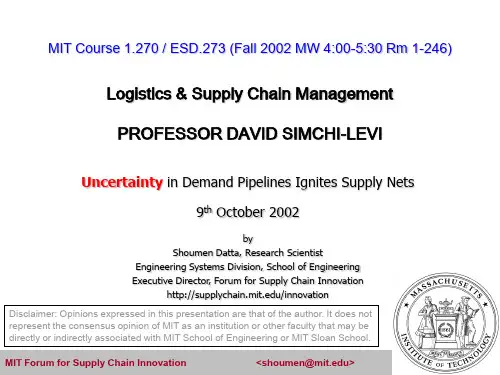
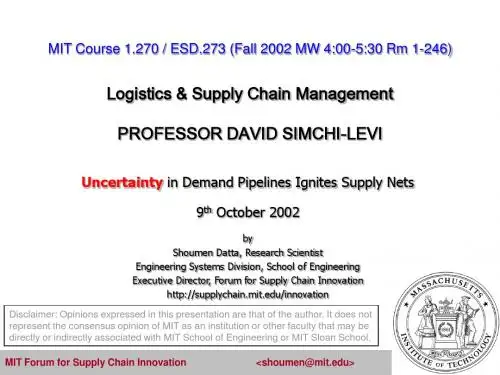
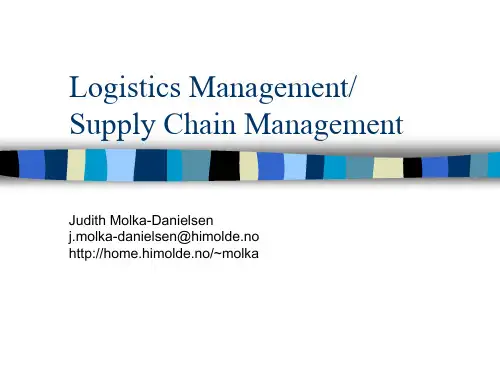
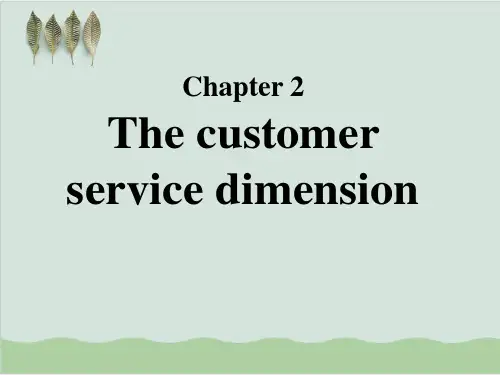
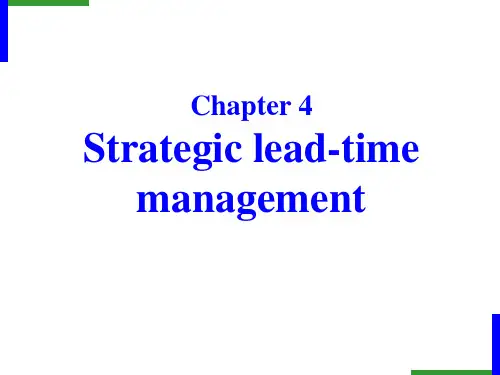
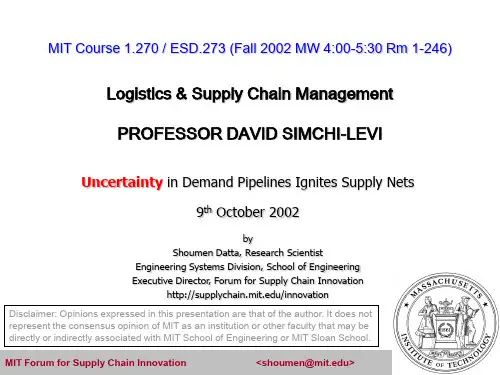
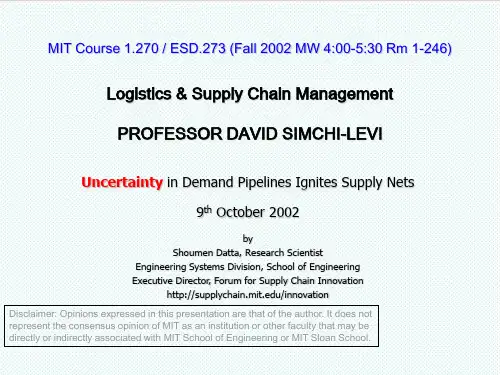
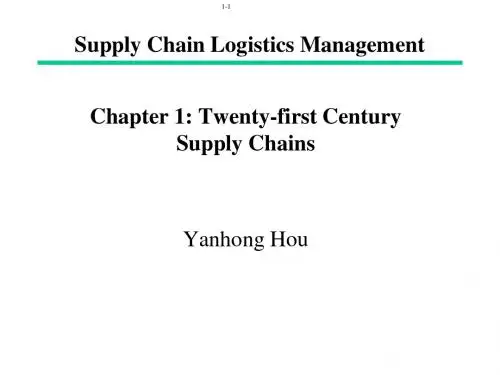
《物流与供应链管理》(LOGISTICS AND SUPPLY CHAIN MANAGEMENT)Capsule summary of the book:The world changes unpredictably, which is dependent on the quick transformation of supply chain to adapt to the variational circumstances. This book focuses tightly on those variations mentioned above, emphasizing the problems that appear whenenterprises attach importance to complicated management, as well as whenforecast-driven business modeltransforms into demand-driven business model. Also, this book elaborates how to gives enterprises dominating and competitivesuperiority with effectivelogistics and supply chain management.Chapter1 Logistics, the supply chainand competitive strategy1.1Supply chain management is a wider concept than logisticsOne goal of supply chain managementmight be to reduce or eliminate the buffers of inventory that existbetween organizations in a chain through the sharing of information ondemand and current stock levels. This is the concept of ‘Co-ManagedInventory’ (CMI).The focus of supply chain management is upon the managementof relationships in order toachieve a more profitable outcome for allparties in the chain. This brings with it some significantchallengessince there may be occasions when the narrow self-interest of one partyhas to be subsumed for the benefit of the chain as a whole.1.2Competitive advantageAt itsmost elemental, commercial success derives from either a cost advantageor a value advantage or, ideally, both. It is as simple as that – themost profitable competitor in any industry sector tends to be the lowestcost producer or the supplier providing a product with the greatestperceiveddifferentiated values.A useful way of examining the available options is topresent them as a simple matrix.Value advantageCost advantageTo summarize, those organizations that will be the leaders in the marketsof the future will be those that have sought and achieved the twinpeaks of excellence: they have gained both cost leadership and serviceleadership.1.3 The supply chain becomes the value chainOrganizations shouldlook at each activity in their value chain and assess whether they have a real competitive advantage in the activity. If they do not, the argumentgoes, then perhapstheyshould consider outsourcing that activity to apartner who can provide that cost or value advantage.1.4The mission of logistics managementThe scope oflogistics spans the organization, fromthe management of raw materials through to the delivery of the finalproduct.The last decade has seen the rapid introduction of flexiblemanufacturing systems (FMS), of new approaches to inventory based onmaterials requirements planning (MRP) and just-in-time (JIT) methodsand, perhaps most important of all, a sustained emphasis on total qualitymanagement (TQM).1.5 The changing competitive environment●The new rules of competition●Globalization of industry●Downward pressure on price●Customers taking controlSummary:This chapter familiarizes the reader with the tenets of competitive strategyand within them the vectors of strategic direction: cost and valueadvantage.Vertically integrated businesses continue to be dismembered, refocusedand transformed into virtual ones held together not by ownership but by closely integrated core business processes and financial engineering.Instead of rivalry and mistrust within the supply chain, newcompetitive pressures are demanding speed and flexibility, which themselvesrequire greater openness and trust. In fact the ability to manageprocess innovation and integration are becoming as important capabilitiesas product innovation.Chapter2T Logistics and customervalue2.1 Delivering customer valueQuality × ServiceCustomer value = ––––––––––––––––Cost × TimeQuality: The functionality, performance and technical specificationof the offer.Service: The availability, support and commitment provided to thecustomer.Cost: The customer’s transaction costs including price and lifecycle costs.Time: The time taken to respond to customer requirements, e.g.delivery lead times.2.2 What is customer service?Customer service could be examinedunder three headings:1. Pre-transaction elementsWritten statements of service policy, Accessibility, Organization structure, System flexibility.2. Transaction elementsOrder cycle time, Inventory availability, Order fill rate, Order status information.3. Post-transaction elementsAvailability of spares, Call-out time, Product tracing/warranty, Customer complaints, claims, etc.2.3 The impact of out-of-stockIn the circumstance of out-of-stock, generally,31%Substitute same brand15%Delay purchase19%Substitute different brand26%Buy item at another store9%Do not purchase itemThe impact of logistics and customer service on marketingConsumerfranchise * Customerfranchise * Supply chainefficiency = Marketingeffectiveness•Brand values•Corporate image•Availability•Customer service•Partnership•Quick response•Flexibility•Reduced asset base•Low–cost supplier•Market share•Customer retention•Superior ROI2.4 Customer service and customer retentionThe importance of customer retention is underlined by the conceptof the ‘lifetime value’ of acustomer. The lifetime value of a customer iscalculated as follows:Lifetime value = Average transaction value× Yearly frequencyof purchase× Customer ‘lifeexpectancy’A prime objective of any customer service strategy should be to enhancecustomer retention.2.5Market-driven supply chainsNow, instead ofdesigning supply chains from the ‘factory outwards’ the challenge is todesign them from the ‘customer backwards’his new perspective sees the consumer not at the end of the supplychain but at its start. In effect this is the philosophical differencebetween supply chain management and what more properly might becalled ‘demand chain management’.1.IdentifyvaluesegmentsWhat do our customers value?2.Define thevaluepropositionHow do we translate theserequirements into an offer?3.Identifythe marketwinnersWhat does it take to succeedin this market?4.Develop thesupply chainstrategyHow do we deliver againstthis proposition?2.6Defining customer service objectivesThe whole purpose of supply chain management and logistics is to provide customers with the level and quality of service that they requireand to do so at less cost to the total supply chain. The perfect order is achievedwhen the customer’s service requirements are met in full.To calculate the actual service level usingthe perfect order concept requires performance on each element to bemonitored and then the percentage achievement on each element to bemultipliedtogether.2.7Setting customer service prioritiesQuadrant 1: Seek cost reductions2: Provide high availability3: Review4: Centralized inventory2.8Setting service standardssome of the key areaswhere standards are essential:Order cycle time Stock availability Order-size constraints Ordering convenience Frequency of delivery Delivery reliability Documentation quality Claims procedure Order completeness Technical support Order status informationthe following measures provide valuable indicators of performance:Pre-transactionStock availabilityTarget delivery dates Response times to queriesTransactionOrder fill rateOn-time deliverBack orders by ageShipment delaysProduct substitutionsPost-transactionFirst call fix rateCustomer complaintsReturns/claimsInvoice errorsService parts availabilitySummary:Ultimately all businesses compete through seeking to deliver superiorcustomer value and logistics processes provide the means by which customerservice is delivered.Logistics management can play a key role in enhancing customerlifetime value through increasing customer satisfaction and enhancedcustomer retention. To achieve this will require the development of amarket-driven logistics strategy and the redefinition of service objectivesbased upon customers’ specific requirements. ‘Perfect order’achievement should form the basis for the measurement of service performanceand the creation of service standard.Chapter3 Measuring logistics costs and performance3.1Logistics and the bottom lineProfitProfitSalesROI = ––––––––––––––––This ratio can be further expanded:ROI = –––––– × –––––––––––CapitalemployedSales Capital employedIt will be seen that ROI is the product of two ratios: the first,profit/sales, being commonly referred to as the margin and the second,sales/capital employed, termed capital turnover or asset turn. Thus togain improvement on ROI one or other, or both, of these ratios mustincrease. Typically many companies will focus their main attention onthe margin in their attempt to driveup ROI, yet it can often be moreeffective to use the leverage of improved capital turnover to boost ROI.3.2 Customer profitability analysisBuildDanger zoneCost engineerProtectChapter4 Creating the responsive supply chain4.1Product ‘push’ versus demand ‘pull’whilst independent demand may be forecast using traditional methods,dependent demand must be calculated, based upon the demand at thenext level in the logistics chain.4.2 The foundations of agilityBusiness process re-engineering (BPR) is the term frequently appliedto the activity of simplifying and reshaping the organizational processeswith the goal of achieving the desired outcomes in shorter time-framesat less cost. Many processes in the supply chain are lengthy because theconstituent activities are performed in ‘series’, i.e. in a linear, ‘one afterthe other’ way. It is often possible to re-engineer t he process so thatthose same activities can be performed ‘in parallel’, i.e. simultaneously.Postponement refers to the process by which the commitment of a productto its final form or location is delayed for as long as possible. Whendecisions on the final configuration or pack have to be made ahead ofdemand there is the inevitable risk that the products that are availableare not the ones the customer wants.The philosophy of postponement ideally would begin on the drawingboard so that products are designe d with late configuration inmind. The longer that products can remain as generic ‘work in progress’ then the more flexibility there will be to ensure the ‘rightproduct in the right place at the right time’.Chapter5 Strategic lead-time management5.1 The concept of lead timeFrom the customer’s viewpoint there is only one lead time: the elapsedtime from order to delivery. Clearly this is a crucial competitive variableas more and more markets become increasingly time competitive.Nevertheless it represents only a partial view of lead time. Just as important, from the supplier’s perspective, is the time it takes to convertan order into cash and, indeed, the total time that working capitalis committed from when materials are first procured through to whenth e customer’s payment is received.5.2 Logistics pipeline managementThe goals of logistics pipeline management are:●Lower costs●Higher quality●More flexibility●Faster response timesAn indicator of the efficiency of a supply chain is given by itsthroughput efficiency, which can be measured as:Value-addedtime*100End-to-end pipeline timeThroughput efficiency can be as low as 10 per cent, meaning that mosttime spent in a supply chain is non-value-adding time.5.3 The lead-time gapReducing logistics lead timeBottleneck managementImproving visibility of demandSummary:Time compression in the pipeline has the potential both to speed upresponse times and to reduce supply chain cost. The key to achievingthese dual goals is through focusing on the reduction of non-value-addingtime –and particularly time spent as inventory. Whereas in the past logisticssystems were very dependent upon a forecast, with all the problemsthat entailed, now the focal point has become lead-time reduction.Chapter6 The synchronous supply chain6.1 The role of information in the virtual supply chainFunctions of a logistics information system:Planning functionCo-ordination functionDatabaseCustomer servicecommunication functionControl function6.2 Implications for logisticsThe basic principle of synchronization is to ensure that all elements ofthe chain act as one and hence there must be early identification ofshipping and replenishment requirements and, most importantly of all,there must be the highest level of planning discipline.In a synchronous supply chain the management of in-bound materialsflow becomes a crucial issue.The idea of ‘stockless distribution centres’ or ‘cross-docking’enables a more frequent and efficient replenishment of product frommanufacture to individual stores.6.3 ‘Quick response’ logisticsWhat has made QR possible is thedevelopment of information technologyand in particular the rise ofInternet-enabled data exchange, bar coding, the use of electronic pointof sale (EPOS) systems with laser scanners and so on.Quick responseLess inventoryrequiredReducedlead timesLesspipelineinventoryLesssafety stockReducedforecastingerrorSummary:The key to supply chain responsiveness is synchronization.Synchronization implies that each entity in the network is closely connectedto the others and that they share the same information. In thepast there was often limited visibility, either upstream or downstream,meaning that organizations were forced to act independently, makingtheir own forecasts, and, as a result, i nevitably relying upon a ‘push’rather than a ‘pull’ philosophy.Chapter7 Managing the global pipeline7.1 The trend towards globalization in the supply chainFocused factoriesCentralization of inventoriesPostponement and localization7.2 Gaining visibility in the global pipelineSupply chain event management (SCEM) is the term given to theprocess of monitoring the planned sequence of activities along a supplychain and the subsequent reporting of any divergence from that plan.Ideally SCEM will also enable a proactive, even automatic, response to deviations from the plan.Chapter8 Managing risk in thesupply chain8.1 Why are supply chains more vulnerable?A focus on efficiency rather than effectivenessThe globalization of supply chainsFocused factories and centralized distributionThe trend to outsourcingReduction of the supplier base8.2 Understanding the supply chain risk profileSupply chain risk = Probability of disruption × ImpactThis audit shouldexamine potential risk to business disruptions arising from five sources: Supply riskDemand riskProcess riskControl riskEnvironmental risk8.3 Managing supply chain risk1.Understand the supply chain2.Improve the supply chain3.Identify the critical paths (nodes and links)4.Manage the critical paths5.Improve network visibility6.Establish a supply chain continuity team7.Work with suppliers and customers to improvesupply chain risk management proceduresSummary:All the evidence indicates that as markets become more volatile and thebusiness environment more turbulent, so supply chains become more vulnerableto disruption. Not all of the risk to supply chain continuity isexternal. Significant risk can be created as a result of management decisionsthat are taken on supply chain design and strategy.Chapter9 Overcoming the barriers tosupply chain integration9.1 Creating the logistics visionIdeally the logistics vision should be built around the simple issue of‘How do we intend to use logistics and supply chain management tocreate value for our customers?’The four elements of logistics-derived customer value highlightedpreviously are ‘Better, Faster, Cheaper, Closer’ and the criterion for agood logistics vision s tatement is that it should provide the roadmapfor how these four goals are to be achieved.9.2 Developing the logistics organizationThe horizontal organization has a number of distinguishing characteristics.It is:Organized around processesFlat and de-layeredBuilt upon multi-functional teamsGuided by performance metrics that are market-based9.3 BenchmarkingCompetitive benchmarking might simply be defined as the continuousmeasurement of the company’s products, services, processes andpractices against the standards of best competitors and other companieswho are recognized as leaders. The measures that are chosen forthe comparison must directly or indirectly impact upon customers’evaluation of the company’s performance.Identifying logistics performance indicatorsThe idea behind the balanced scorecard is thatthere are a number of key performance indicators –most of them probablynon-financial measures –that will provide management with abetter means of meeting strategic goals than the more traditional financiallyoriented measures.Step 1: Articulate logistics and supply chain strategy2: What are the measurable outcomes of success?3: What are the processes that impact these outcomes?4: What are the drivers of performance within these processes?In this framework the four key outcomes of success are suggested to be:Better, Faster, Cheaper, CloserSummary:internally integrated across functions and they are externally integratedwith upstream suppliers and downstream customers. Many companiesare impeded in their attempts to become more agile and responsivebecause of an entrenched functional structure. They manage functionsrather than processes and hence have a fragmented approach to themarketplace. It is also difficult for such firms to contemplate externalintegration when they lack internal integration.Chapter10Entering the era ofnetwork competition10.1 Seven major business transformationsFrom supplier-centric to customer-centricFrom push to pullFrom inventory to informationFrom transactions to relationshipsFrom ‘trucks and sheds’ to ‘end-to-end’ pipeline managementFrom functions to processesFrom stand-alone competition to network rivalry10.2 From 3PL to 4PL™Third-party logistics service providers are companies who provide arange of logistics activities for their clients. They might operate distributioncentres, manage the delivery of the product through theirtransport fleets or undertake value-adding services such as re-packing.The fourth-party logistics service provider was that because modern supply networksare increasingly global and certainly more complex, the capabilities tomanage the network probably do not exist in any one organization. Insuch situations, there is a need for an organization who can use itsknowledge of supply chains and specialist third-party service providersto manage and integrate the complete end-to-end supply chain.The 4PL™ would assemble a coalition of the ‘best of breed’ serviceproviders and – using its own information systems capability – ensure acost-effective and sustainable supply chain solution.Whether the 4PL™ be a joint venture or some other model there arefour key components that must be in place. These are:1. Systems architecture and integration skills2. A supply chain ‘control room’3. Ability to capture and utilize information and knowledge across the network4. Access to ‘best of breed’asset providers。